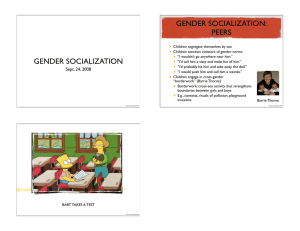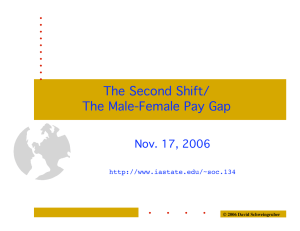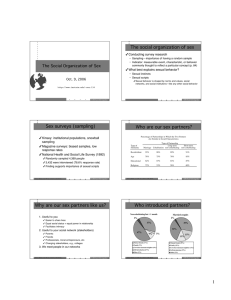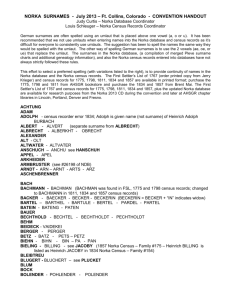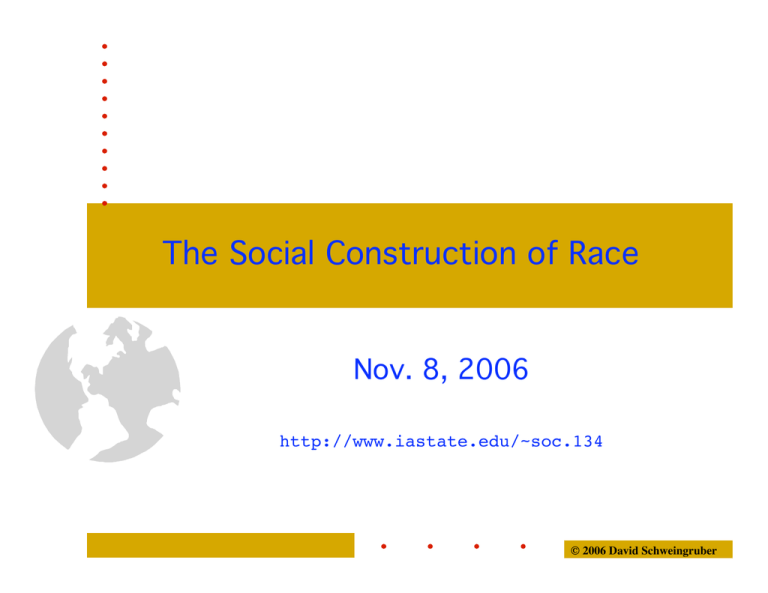
The Social Construction of Race
Nov. 8, 2006
http://www.iastate.edu/~soc.134
© 2006 David Schweingruber
Sociology Club Movie Night
The movie Lone Star will be featured at Sociology
Club Movie Night, Thursday, Nov. 9, at 7 p.m. in
Coover Hall 2245.
Discussion afterwards will be led by a panel of
faculty members: Terry Besser, Brian Monahan,
and Steve Sapp.
Dave Schweingruber is hosting.
©©2006
2000David
DavidSchweingruber
Schweingruber
U.S. racial system complications
The U.S. racial system has focused on the white-nonwhite dichotomy
• The one drop rule: one drop of black blood (i.e., any percentage of
ancestry) makes someone black
• Until 1967, many states had laws against miscegenation (marriage or
sexual relations between a man & a woman of different races)
People and groups move from one racial category to another
• Because of the one-drop rule, many blacks throughout U.S. history have
looked white enough to “pass” as white; this has resulted in a large
percentage of whites with black ancestry
• New immigrant groups, e.g., Irish, Slavs, have been successful in becoming
white
Census categories
• Races: American Indian or Alaska Native, Asian, Black or African American,
Native Hawaiian or Other Pacific Islander, White, Some other race
• Ethnic category: Hispanic or Latino
©©2006
2000David
DavidSchweingruber
Schweingruber
Question 5—2000 Census
©©2006
2000David
DavidSchweingruber
Schweingruber
Question 6-2000 Census
©©2006
2000David
DavidSchweingruber
Schweingruber
History of census categories
1860: three categories: white, black, mulatto
Mulatto split into into three (octoroon, quadroon, mulatto) in 1890, recombined
in 1900 and dropped after 1920
American Indian added in 1870, tribal affiliation asked for beginning 1900,
changed to American Indian or Alaska Native in 2000; (Aleut 1960, 1980-90)
Asian: Chinese added 1870; Japanese 1890; Filipino 1920; Korean 1920-1940,
1970-2000; Hindu 1920-1940, Asian Indian 1980-2000; Vietnamese 1980
Pacific Islander: Hawaiian 1960, Guamanian 1980; Samoan 1980; P.I. split from
Asian in 2000
Mexican added 1930, then dropped; Hispanic ethnicity added 1980
Other race added in 1910
©©2006
2000David
DavidSchweingruber
Schweingruber
U.S. racial composition—U.S. Census
Total pop.: 281,421,906 (100.0%)
One race: 274,595,678 (97.6%)
White:
211,460,626 (75.1%)
Black:
34,658,190 (12.3%)
Indian/AN:
2,475,956 (0.9%)
Asian:
10,242,998 (3.6%)
Hawaiian/PI:
398,835 (0.1%)
Other:
15,359,073 (5.5%)
Two or more:
6,826,228 (2.4%)
Latino:
Not Latino:
35,305,818 (12.5%)
246,116,008 (87.5%)
White
75.1%
Other
5.5%
Source: 2000 Census
Black
12.3%
Two or
more
2.4%
Hawaiian/
PI
0.1%
Asian
3.6%
Indian/
AN
0.9%
©©2006
2000David
DavidSchweingruber
Schweingruber
Multiple racial combinations
Two races or more races: 6,826,228 (100.0%)-2.4% of pop.
Two races: 6,368,075 (93.3%)-15 combinations
White & other: 2,206,251 (32.3%)
White & Indian: 1,082,683 (15.9%)
White & Asian: 868,395 (12.7%)
White & Black: 784,764 (11.5%)
Black & other: 417,249 (6.1%)
Three races: 410,285 (6.0%)-20 combinations
White, black & Indian: 112,207 (1.6%)
Four races: 38,408 (0.6%)-15 combinations
Fives races: 8,637 (0.1%)-6 combinations
Six races: 823
Source: 2000 Census
©©2006
2000David
DavidSchweingruber
Schweingruber
U.S. vs. Iowa
U.S. racial composition
Iowa racial composition
White
75.1%
Black
12.3%
Two or
more
2.4%
Other
5.5%
White
93.9%
Hawaiian/
PI
0.1%
Source: 2000 Census
Asian
3.6%
Indian/
AN
0.9%
Two or
more
1.1%
Other
1.3%
Hawaiian/
PI
0.0%
Black
2.1%
Indian/
Asian AN
1.3% 0.3%
©©2006
2000David
DavidSchweingruber
Schweingruber

